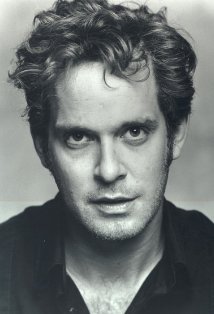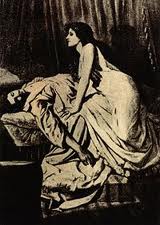
Vampire by Edward Burne Jones
Imagine you are a vampire hunter on the trail of a beautiful young girl who has just been taken by the evil yet strangely alluring Count Dracula and you have ventured into the family crypt to release her from her terrible curse and allow you and your family to sleep at night without a string of pungent alliums and a sharpened piece of two b’four.
The vampire appears!!!! Aarrghghg! You dive into your bag for the acknowledged accoutrements of vampire slaying; garlic, wooden stake, crucifix … when suddenly you remember that you’re Jewish. What do you wave at the advancing fanged predator?
I’m sorry to say that this is a situation that has been vexing me for some months now, so I did the only thing possible. Some research.
Vampire legends go much further back than one might imagine, although the word ‘vampire’ only really came into common usage in the 18th century and comes originally from Serbia.

Lilith - first wife of Adam
Mysterious creatures of the shadows who feast off the living exist in the myths and legends of nearly every culture around the world. Early Hebrew writings describe a winged demon with the body of a woman and talons like an owl. Her name was Lilith and she was the first wife of Adam and, as she was created from the same earth as him, she believed herself to be his equal. But she refused to be submissive, so God banished her to the realm of demons after which she was believed to devour infants and small children, seduce men, steal their semen and then drink the blood of her victims. She vowed to feed off the children of Adam i.e. humans, forever. Without Lilith there would be no vampires.
This type of vampire is called an estrie and the only way to make sure she stays dead is to stop up her mouth with earth. Estries don’t always attack in obvious ways and they would sit on hands or fingers, waiting for the person to rub their eyes or mouth and they could then enter the body. To prevent an attack by vampires, Jews would place a bowl of water at the side of the bed to wash their hands before walking, thus preventing invasion.
Vampire legends appear all over the world and it occurs to me that the form which the creature takes tells us something about the psyche of the region. Often the vampire will appear in the guise of a beautiful woman in order to gain access to its prey whilst others present as monsters, animal forms or pallid and degenerate replicas of humans. They are often shape-shifters which adds another layer of fear as the vampire hunter may not even know what he’s looking for.
Vampires legends in brief:
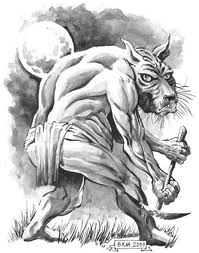
China - Chiang-shih
China – Chiang Shi: A recently deceased corpse who becomes possessed by a demon, covered with white or green hair, with long claws, teeth, glowing red eyes and lethal halitosis. It can fly and change into a wolf. Repelled by garlic, salt and rice. Killed by a bullet or thunder.
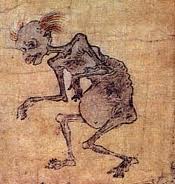
Japan - Gaki
Japan – Gaki: Pale-skinned, cold and hollow-eyed blood drinkers. Can shape-shift, impersonate humans and possibly go invisible.
Philippines – Aswang: Beautiful woman by day, tubular-tongued blood drinker by night. Prefers children and after eating them, its belly swells and it flies home and breastfeeds its own children with the blood.

India - Rakshasa
India – Rakshasa: If a child is forced to eat human brains it becomes a Rakshasa who then needs human blood. Again a shape-shifter, sometime a beautiful human, sometimes animal. It lurks in trees to spy out its victims and if you so much as stray into its territory you will become seriously ill.
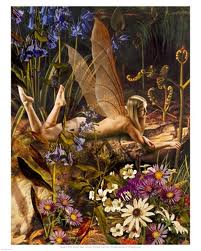
Ireland - Leahaun-shee
Ireland – Dearg-Due: This ancient vampire goes all the way back to the Celts. The only way to stop it is to pile stones on the grave if you suspect the incumbent might be a vampire.
The Irish also have the Leahaun-shee who is not technically a vampire but is vampiric in nature. A beautiful woman, she lures young men under her spell and then effectively shags them to death. I’ve known women like that.
Scotland – BaoBahan-sith: is similar to the Leahaun-shee but is always dressed in green.
Germany – Doppelsauger: In the Slavic region of northern Germany, the Wends believed that once a baby was weaned, if it was breastfed again it would turn into a vampire. It would eat the breast and take the life force of the mother.
Africa: the Africans are generally terribly keen on vampire stories and have Asanbosam, Adze, Impundulu and Ramanga to name but a few. The Ramanga is my personal favourite because it not only drinks blood but eats the toe nail clippings of nobles. Now that is truly horrible.
The Americas are awash with stories because they have the varied cultures of French and African Voodoo, the West Indies and South America as well. Their monsters are often female and often corruptly sexual in nature. The Chupacapra of Mexico/Puerto Rico is particularly well known as a creature that eats the flesh and drinks the blood of domesticated animals.
Isn’t it interesting how often these creatures are female and involve breasts and babies? Is it at all possible that some of these stories emerged in cultures who were terrified and mystified in equal measure of blood, women, childbirth, breast feeding and women’s perceived power to enchant and ensnare?

Nosferatu
Modern Vampires
Although vampires have appeared in fiction and poetry since the 1700s, it was Bram Stoker’s ‘Dracula’ which changed the depiction of vampires into elegant, sophisticated and desirable beings with their romantic suggestions of virginity, sex, blood and death.
Now, of course, vampires are all the rage with ‘The Vampire Diaries’ and the ‘Twilight Saga’ and psychologists think that this has come about through a combination of the modern fascination and pre-occupation with sex and the enduring terror of our own mortality.
But what’s really interesting is that every so often, present day societies will still become convinced that vampires are among them, these hysterics often emerging at times of terrible political or economic turbulence.
In 1970 it was rumoured that a vampire haunted Highgate Cemetery in London which a local man claimed to have exorcised and even that he destroyed a ‘nest’ of vampires in the area.
In 2002 stories of vampire attacks swept through Malawi in Africa which culminated in one individual being stoned to death and four others being attacked, one of whom was the Governor who was believed to be colluding with the undead.
In 2004 a Romanian family feared that their dead relative had become a vampire so they sensibly dug up his corpse, ripped out his heart, burnt it, mixed the ashes with water and drank it.
Clearly vampires are everywhere so, in true Wartime Housewife style, here are my top tips for repelling or killing these modern-day, blood-sucking hooligans.
How do you know if a grave contains a vampire? Get a virgin boy to ride over the grave, naked and bareback on a virgin stallion. When the horse stops at a grave and won’t move forward, there’s your vampire.
Preventative Measures: Garlic, nailing clothes to coffin walls, do not invite them in to your house (no really, don’t), religious symbols* made of silver, mustard seed, wolfsbane, mirrors will sometimes repel.
Killing a vampire: sunlight, a wooden stake through the heart, preferably made of aspen or hawthorne (although this might just immobilise it), decapitation (dead cert), total immersion in running water or fire, drinking the blood of the dead, a silver bullet or knife, holy water, nail its coffin shut with silver nails.
* In order to bring this fascinating subject back to the beginning, religious symbols are a relatively modern method of protection. The Catholic church decided that they, and only they, had the power to kill vampires and this is where the idea that a cross would repel these beasts but only, only mind you, if it was held by a true believer. Presumably the unbelievers deserved to die. They also had the monopoly on holy water which should be thrown directly onto the vampire in question.
If you are at all worried, please feel free to contact this website for further advice. And consider adding silver nails, sharpened sticks and a small phial of holy water to your DIY kit. The rest, as one would expect, are probably Storecupboard Ingredients.
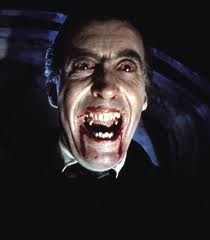
Christopher Lee - that's more like it

